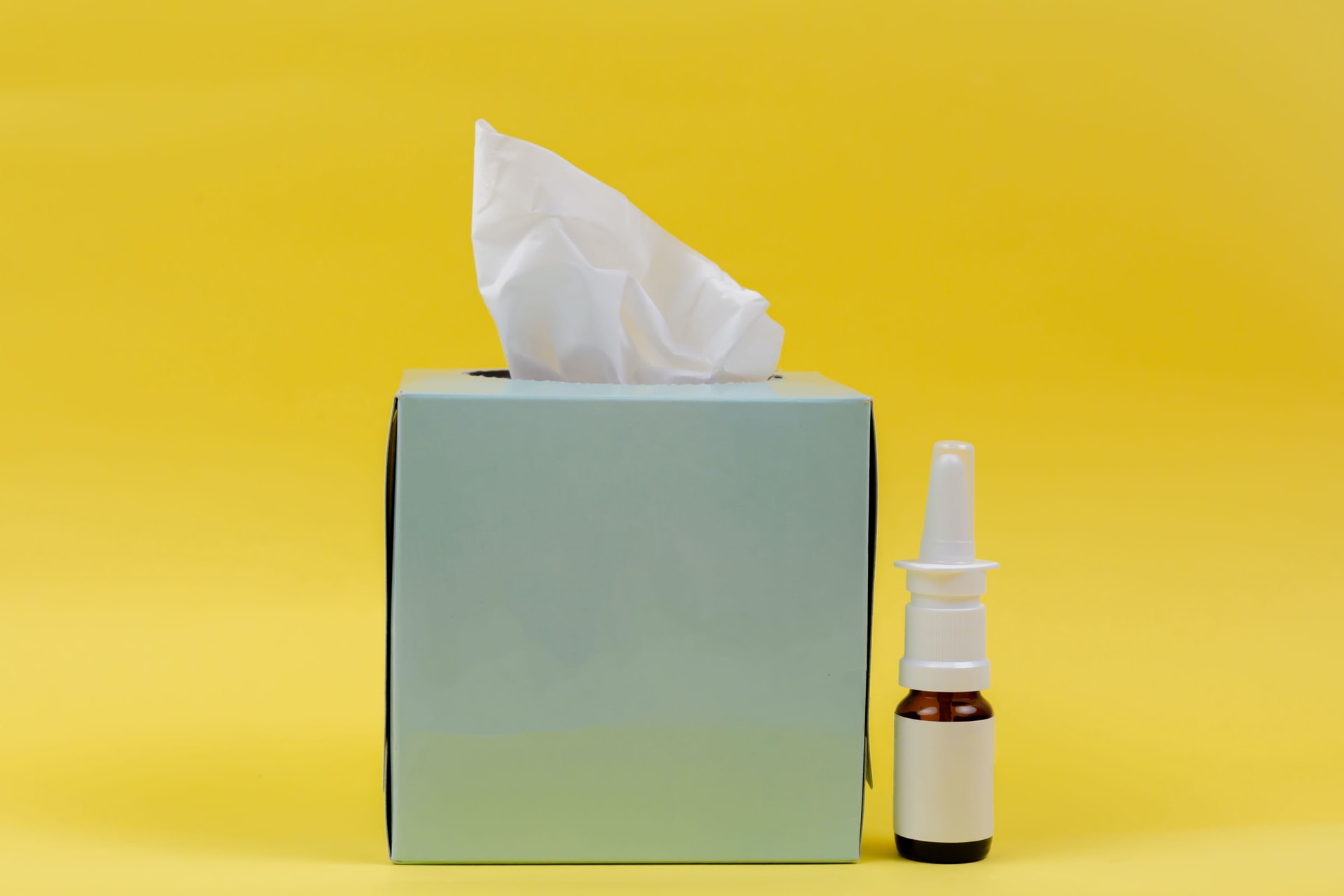Have you noticed that you’ve become seemingly more and more sensitive to allergens over the past decade? It’s not just you, don’t worry. Studies like this one have shown that the rate of airborne allergens, like pollen, have risen significantly over the past twenty years as overall global temps have continued to climb. This means that there is a continually higher pollen count in the air, and the duration of pollen seasons is longer and longer. The result of these factors is that more and more people are noticing sensitivities. This isn’t because allergens are different; instead, there are more of them, so less sensitive people overall are finding that they are increasingly bothered by seasonal allergies.
Similarly, there is an increasing awareness around food allergies as well. The ability of science to detect our allergies has gotten much stronger over the past decades, as has our appreciation for and understanding of how much food impacts our systems in unique ways.
Time was, if you had an allergy to something like gluten, your life had to change drastically. While there are definitely still very serious allergies, like those to shellfish, peanuts, or bee stings, in other areas, we have come a long way in our journey to help those with allergies not have to miss out altogether. Consider 30 years ago—if you were allergic to gluten or peanuts, chances are, you wouldn’t be able to walk into your local grocery store and pick up almond butter or a loaf of gluten-free bread from the bakery. Or even know that was an option! Our education around allergies has come a long way, and now we can confidently build an allergy-friendly home environment. Keeping a home clean is also an important factor, not only for keeping allergies at bay but because of all the health benefits that it brings to our overall health. Whether you have airborne allergies that can cause asthma or food allergies that can cause an anaphylactic reaction, it is important to prepare your home to avoid the triggers, and it is also a good idea to have and asthma & anaphylaxis emergency kit in hand, in case it is needed.
Food Allergies

Let’s be real, food allergies suck, and there’s no getting around it. We’re sure that if you could choose to just… not be allergic to something, you would. Life would be simpler, right? But, there are so many options these days to replace the thing you are allergic to with a substitute that means you can still eat the types of foods you enjoy, there are some great allergy-free lunch ideas out there. Additionally, often being more aware of what you’re eating can create more healthy eating habits, so there’s always a silver lining to be found.
Gluten
First things first, gluten sensitivity is different from a gluten allergy, both of which are different from having Celiac Disease. Confused yet? Let’s sort it out:
Gluten sensitivity is when your digestive system is reactive to gluten but does not have a histamine reaction like when you have an allergy. Plenty of people are sensitive to gluten in the sense that if they have too much, they might get an upset stomach or experience mild bloating, if you have a gluten sensitivity it’s important to stay informed about the different types of gluten-based foods.
Gluten allergy is when your body produces histamine in response to gluten exposure. You might be familiar with the word histamine because we commonly take antihistamines as treatments for many allergic reactions. People with gluten allergies can experience digestive symptoms as well as more common food allergy reactions like itching and rashes.
Celiac Disease is not an allergy. There is no histamine reaction from gluten. Rather, Celiac is an autoimmune disease most closely linked to Rheumatoid Arthritis or Lupus. Celiac disease symptoms vary between individuals but can include digestive symptoms, skin rashes, and joint inflammation.
There! Now that you know what the different types of gluten-related sensitivities are, there’s good news—the treatment for all of them is pretty much the same. While those with gluten allergies and Celiac Disease tend to be more sensitive, the products that are common substitutes are the same.
Kitchen Organization Hacks
If you’re creating a gluten-friendly kitchen but also not wanting to go completely gluten-free (GF), some easy organization hacks can help you accommodate your gluten-intolerant friends and family members.
- Have dedicated GF counter space. This helps prevent cross-contamination and gives your GF person space that they know is safe.
- Create a GF baking bin. It might seem daunting to bake and cook with separate GF ingredients, so we suggest creating a GF baking and cooking bin that stays separate in your pantry. This way, you can pull out your bin and be confident that you haven’t mixed in any non-GF items.
- Set aside a GF fridge shelf. GF items tend to be more expensive, so if not all of your family is GF, chances are, you don’t want everyone scarfing down the expensive soy sauce, bread, and GF treats. A dedicated shelf can help with this by letting other fridge users know what’s off-limits.
- Learn the level of sensitivity you’re dealing with. Many people are Celiac, but that doesn’t necessarily mean their sensitivity is super strong. Similar to how you can be allergic to things at different levels, the same is true for gluten. Some people have strong allergic reactions that any cross-contamination causes a strong reaction. Learning about this can help you organize your kitchen.
Cross-Contamination
Most of the tips above are about preventing cross-contamination as this is the most common way that people who are GF are exposed to gluten. Depending on the severity of the reaction of your GF loved ones, or yourself, you might be best advised to create an entirely GF kitchen. If not, creating safe spaces in your kitchen is key!
Food Alternatives
Many GF items are made with grain alternatives like the following:
- Amaranth
- Brown, white and wild rice
- Buckwheat
- Almond meal flour
- Coconut flour
- Corn
- Cornstarch
- Guar gum
- Millet
- Pea flour
- Potato flour
- Potatoes
- Quinoa
- Sorghum
- Soy flour
- Teff
Peanuts

Peanut allergies are serious and can be very severe, so being aware of the level of allergic reaction that your friend or a family member has is essential. Peanut allergens can be especially tricky because peanuts are oily. If the allergy is severe, even a trace amount of leftover peanut oil that evades your diligent cleaning can be a problem.
Kitchen Organization Hacks
- Keep a separate set of cooking utensils and cutlery. This is one of the best ways to prevent trace amounts of peanut oil from triggering an allergic reaction.
- Consider implementing the “3-check rule”. Any groceries coming into your house get checked at the store, at home when unloading where they’re labeled, and again before eating them for the first time. This is a lot of due diligence but an effective way to reduce the accidental consumption of allergens.
- Establish a routine. If you are going to have allergens in your kitchen so that others can still enjoy them, make sure that the allergic person’s food is always put at the same place on the table or spot on the counter.
Cross Contamination Prevention
Clean, clean, clean! The best way to get the most thorough clean is always to use a dishwasher if you can. No shade to your handwashing skills, but a dishwasher will wash with hotter water and for longer than you can reasonably do at the sink, meaning that less of that sneaky peanut oil is likely to cling to dishes and cutlery.
Food Alternatives
The popularity of nut butters that are not peanut-based has risen significantly in past years, partly as allergen substitutes and partly for health reasons. Either way, it’s super simple now to find nut butters made of sunflowers, cashews, almonds, walnuts, or hazelnuts, among others.
Lactose
Lactosectose is a common intolerance but, luckily, pretty straightforward to work around. A few easy tips and you’re on your way to providing dairy-free options for your lactose-free loved ones, you can also find great cheese for lactose intolerance.
Kitchen Organization Hacks
- Designate a separate shelf in the fridge. Most lactose-containing items are refrigerated, so make sure there’s a lactose-free zone in your fridge.
- Label everything! Clear labeling will mean that your more expensive lactose-free items don’t get accidentally scooped up by other people in your house. (Thereby robbing them of that sweet, sweet lactose, too!)
Cross Contamination Prevention
Cross-contamination with lactose is happily much easier to avoid than the other allergens we’ve covered so far. Basically, just don’t accidentally use the wrong product when you’re cooking (hence the careful labeling), and you’re set. Lactose-intolerance does occur to varying degrees as well, but trace allergens from a knife that was once used to spread butter and then was washed are unlikely to cause a reaction in the same way as a knife that was used to spread peanut butter could cause a reaction in someone with a severe peanut allergy.
Food Alternatives
Lactose intolerant dairy lovers, rejoice! There are tons of dairy alternatives to make sure you don’t have to miss out on any of your favorite foods. The most common dairy products have multiple substitutes, including:
- Milk
- Butter
- Cheese
- Yogurt
- Ice Cream
Egg

Eggs are included in many homemade and store-bought items, and the tricky thing can be that if you’re not on the up and up with all of the various names that egg-containing ingredients hide under, you can miss them. The good news is that there are many resources for education and to help you keep track of what’s safe and what isn’t.
Kitchen Organization Hacks
- Keep a list of ingredient names on the fridge that contain eggs but don’t have the word ‘egg’ in them.
- Consider implementing the “3-check rule”. Like peanut allergies, egg allergies can be very severe, so using the three-check rule is helpful.
- Keep an eye on the ingredients lists for non-food items, too. Things like hair care products, craft materials like glue, and medications are all potential spots where eggs could be hiding.
Cross Contamination Prevention
Similar to peanut allergies, your level of cross-contamination vigilance will depend on the severity of the allergy you’re dealing with. It could be as simple as not using eggs in someone’s dish, or you might need a complete set of egg-free kitchen tools and cutlery.
Food Alternatives
Thanks to the innovative spirits of the vegan community, egg substitutes are becoming ever more inventive and popular. Check out this huge list for some egg replacements that you can make from things you probably already have in your kitchen.
Air Allergy

Airborne allergens generally belong in one of these categories – pollen, dust, pet hair, or pet dander and they can cause allergic asthma. The good news is, the way to reduce the reaction in your home to all three is similar. Follow our easy steps, and you’ll be well on your way to an allergy-free home.
Pollen
Pollen is that evil supervillain that is always hatching a plan to come back and get you. Year after year, you can bet that pollen is waiting for its chance. Luckily, you can be smarter than pollen and foil its evil plans with a few easy tips and tricks.
Dust
Dust contains tiny particles that can be the cause of allergies. Mold is a common culprit here, as small particles get trapped in dust that lurks around your home and is then breathed in. Dust allergy is one of the most common.
Home Cleaning Hacks
Buy an air purifier. This technology is ever-evolving and can significantly improve your quality of life if you suffer from airborne allergies.
Get rid of clutter and things that attract and trap dust and pollen. There are some common dust traps in many homes that can be removed to ease the amount of pollen trapped in your home. Things like carpet, upholstered window coverings, and dusty books are all culprits for harboring sneeze-inducing pollen. If you don’t want to remove your carpets, a periodic carpet cleaning is really important to get rid of dust mites, pet dander, pollen, mold, and mildew, among other things.
Invest in a quality vacuum cleaner. This one is important across the board. Keeping your home clean will help with reducing the amount of pollen in the air and reduce your allergy reactions. Certain brands have focused on the quality of the air filters in their vacuums, and their products are recommended for allergy sufferers.
When vacuuming, it’s important to take your time and practice slow vacuuming to reduce allergies. Take your time when doing it, try vacuuming in slight diagonals, creating Vs and Ws, this will help to really remove the dust, pollen, and more from your fabrics, rugs, and carpets. You’ll notice the difference in cleanliness and reduced allergy symptoms. You can learn more about slow vacuuming here.
Ventilation Tips
Clean your ducts. Air ducts get clogged up with pollen throughout the year and can result in your home being the very place that’s causing your allergies. Keeping your HAVC system clean can greatly help to reduce allergens in the air.
Your furnace is constantly cycling air through your home, and part of its job is to filter that air. When your furnace filter gets clogged, it becomes less efficient at filtering dust, pollen, and pet hair, which results in all of those allergens being recycled back into the air, which is why it is important to clean and service your furnace at least once a year.
Keep humidity levels stable. Most of us know that overly humid conditions can foster mold, but did you know that dry air can also be a culprit for spreading allergens? When the air in your home is too dry, it’s easier for small particles to get scooped up and scattered throughout your home, causing you trouble.
Be aware of harmful chemicals. Chemicals are nearly ever-present in our homes, but luckily there is a growing awareness around how harmful some of these products can be long-term and more options for alternatives. Something sneaky that you might not know about is how often our furniture is made with toxic products. Grocery store cleaning products also often contain harsh ingredients that can exacerbate allergies. If you’re looking for a way to know what’s safe and what isn’t, there are apps that can be a great resource. Just put in the name of a product you’re curious about, and you’ll get back a rating on how harmful it is.
Must-Have Products
Speaking of products, here are a few that are highly recommended to use in your home to reduce the occurrence of allergens, natural is best:
- Microfibre cleaning cloths for dusting – trap dust instead of stirring it into the air.
- Cleaning products with the Green Seal Approval – this organization provides standards for chemical-free products and helps you be confident with your purchases.
- Make your own cleaning products – almost without a doubt, your kitchen is already full of the ingredients you need to make great cleaning products. Nothing like making it yourself to know what’s in it! If you’re looking for inspiration, head to Pinterest or Google and search ‘DIY cleaning products’.
Allergy-Friendly Pet Breeds

Another way to ease the suffering of those afflicted with pet allergies is to look for hypoallergenic dog breeds. This has become more and more popular in recent years, and the variety has greatly increased.
You don’t have to break the bank looking for a fluffy friend that won’t send you sneezing, there are several cheap hypoallergenic breeds that don’t shed much hair and that can adapt to your budget and size preference.
Below you’ll find some popular hypoallergenic dog breeds.
Dogs
- Afghan Hound
- Schnauzer
- Peruvian Inca Orchid
- Poodle
- Kerry Blue Terrier
Cats
- Balinese
- Siberian
- Oriental Shorthair
- Devon Rex
- Ocicat
Rodents
- Hamster
- Guinea Pig
- Gerbil
- Rabbit
- Chinchilla
Now that you’ve learned all about different types of allergies and how to keep your home allergy-friendly, it’s time to get to work so you and your loved ones can breathe easier!




